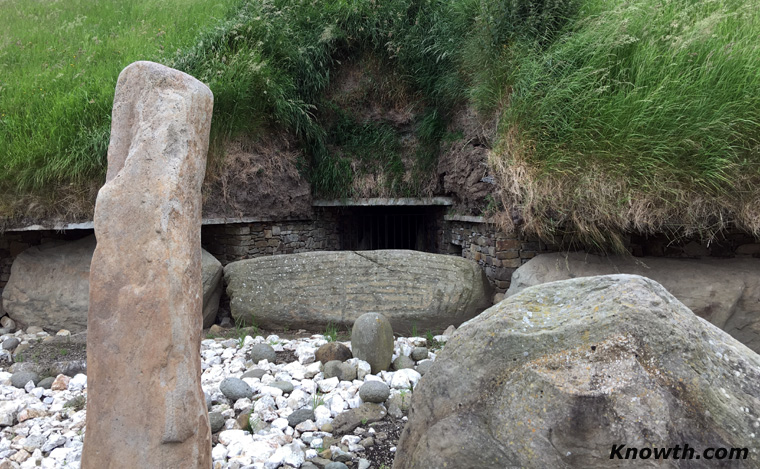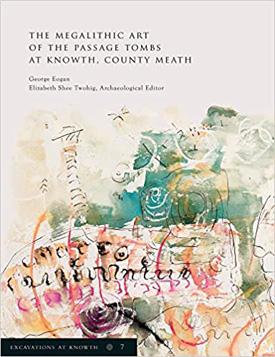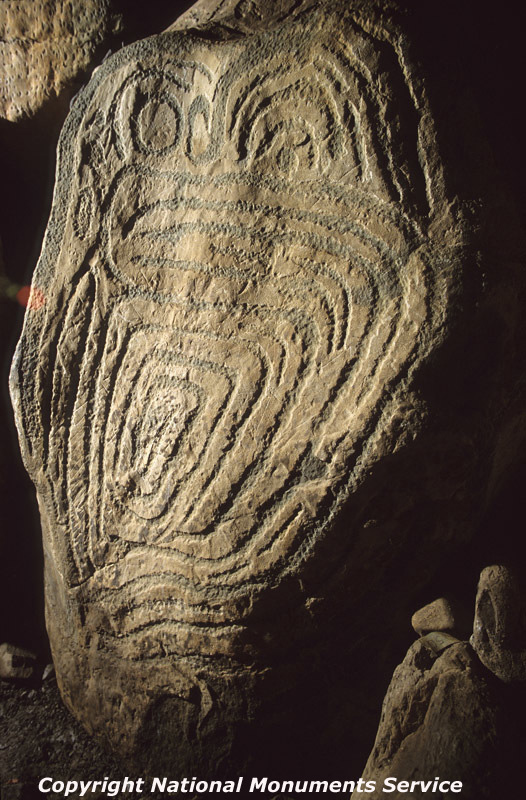Knowth Western Passage

The western passage extends for over a hundred feet (34 meters) and is known as the 'Undifferentiated Passage' because it's hard to differentiate between the passage and the burial chamber itself. Remarkably, the basin stone from the western chamber is currently lodged within the passage.
During a later phase in the tomb's history, an attempt was made to extract the basin stone without realizing that its width exceeded that of the passage. Consequently, the extraction process reached a point where the stone became firmly wedged, and it has remained in that position ever since.
The Western passage and chamber was re-discovered in 1967
The Western passage and chamber was re-discovered in 1967 by the archaeologist George Eogan, he describes the event as follows.In 1967, work on the western side revealed a souterrain (medieval storage chamber). At one end, a wall seemed to run into the mound with a cavity beyond. On the following day, July 11th, careful excavation enlarged the size of the cavity, and that enabled a workman, with the aid of a torch, to look in. He reported that he could see a passage extending inwards for a distance of some metres. On further excavation, using a flash lamp I could see much larger side stones and capstones, one bearing megalithic art. We were thrilled, and all of us in the group - Quentin Dresser, Tom Fanning, Sean Galvin, Fiona Stephens [later to become Mrs Eogan] and myself - speculated on the extent of the tomb. The only way to solve that problem was to climb in, so we set off.
In some places the side orthostats were leaning inwards due to the immense weight of the overlying mound, so we had to crouch and wriggle or go on hands and knees and in one place contend with a pool of muddy water. As there were loose stones on the floor, this was a painful operation. However, in places we could proceed in a hunched position. At one point there was a stone basin astride the passage with a sill-stone beyond it. From there the passage was much better preserved and the capstone roof was much higher. But there was no sign of an end to it.
As we flashed our lamp, we saw that practically every orthostat was highly decorated, and immediately inside of the sill there appeared to be an anthropomorphic figure with two staring eyes. We speculated that this ghostly figure might have represented a guardian of the inner sanctum of the tomb. We could now walk upright, and soon reached the chamber, an undifferentiated structure with two transverse sill-stones and a back stone decorated with parallel lines like a stone at the entrance except for the absence of a vertical line.
By now we had lost all sense of time and distance, so Quentin Dresser volunteered to return to the outside world to inform the rest of the team by now no doubt worried about our fate. Everyone then came into the tomb, and with so much excitement we almost forgot to measure the passage length. When we did, we found that it was 34 metres. It was an incredible occasion, and one that remains as vividly in my memory today as it did on the July evening. What a remarkable experience it was to have been the first in a thousand years to enter one of the greatest monuments of Neolithic Europe.
The Megalithic Art of the Passage Tombs at Knowth, Co. Meath
 Description of Knowth West Orthostat 50
Description of Knowth West Orthostat 50
The central portion of the main face is generally flat, and the sides and top slope back creating four planes, all of which are carved and form a unified composition. Stage 1 consists of incised lines, some of which are deeply cut; the principal panel is a series of chevrons at the lower-left, and there are some shorter, incised lines to the right and on the top of the stone.
Stage 2 consists of an extensive composition of ribbon-like lines picked with a small to medium-sized, rounded point. The composition centres on a vertical line enclosed in a tall, angular, clockwise spiral of two turns. Outside this, a series of swirling lines extends upwards on the right and curves over to form a comma shape around the spiral. Above this is a set of arcs opening downwards, and a circle enclosed in a single arc.
Purchase at Amazon.com or Amazon.co.uk. View or Download at Digital Repository of Ireland.
Boyne Valley Private Day Tour
 Immerse yourself in the rich heritage and culture of the Boyne Valley with our full-day private tours.
Visit Newgrange World Heritage site, explore the Hill of Slane, where Saint Patrick famously lit the Paschal fire.
Discover the Hill of Tara, the ancient seat of power for the High Kings of Ireland.
Book Now
Immerse yourself in the rich heritage and culture of the Boyne Valley with our full-day private tours.
Visit Newgrange World Heritage site, explore the Hill of Slane, where Saint Patrick famously lit the Paschal fire.
Discover the Hill of Tara, the ancient seat of power for the High Kings of Ireland.
Book Now
Home
| Newgrange
| Knowth
| Dowth
| Hill of Tara
| Fourknocks
| Loughcrew
| More Places
| Labyrinths
| Local Info
| Art Works
| Articles
| Images
| Books
| Links
| Boyne Valley Tours
| Contact

